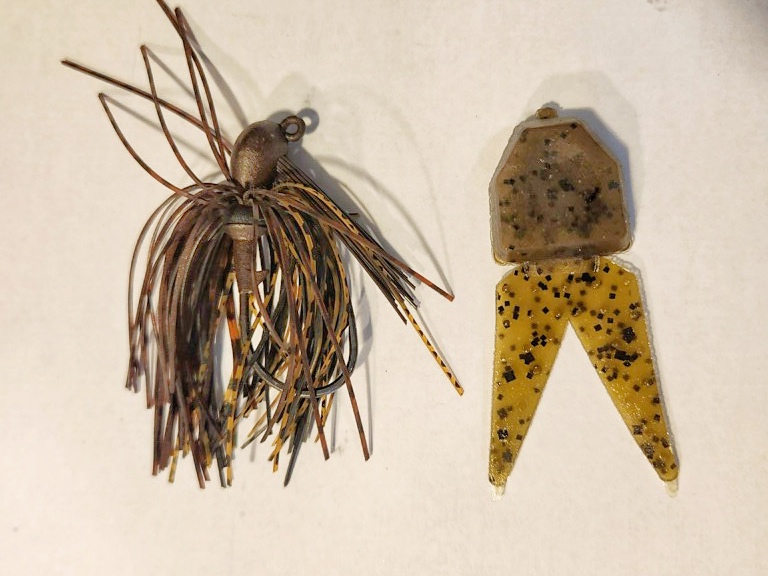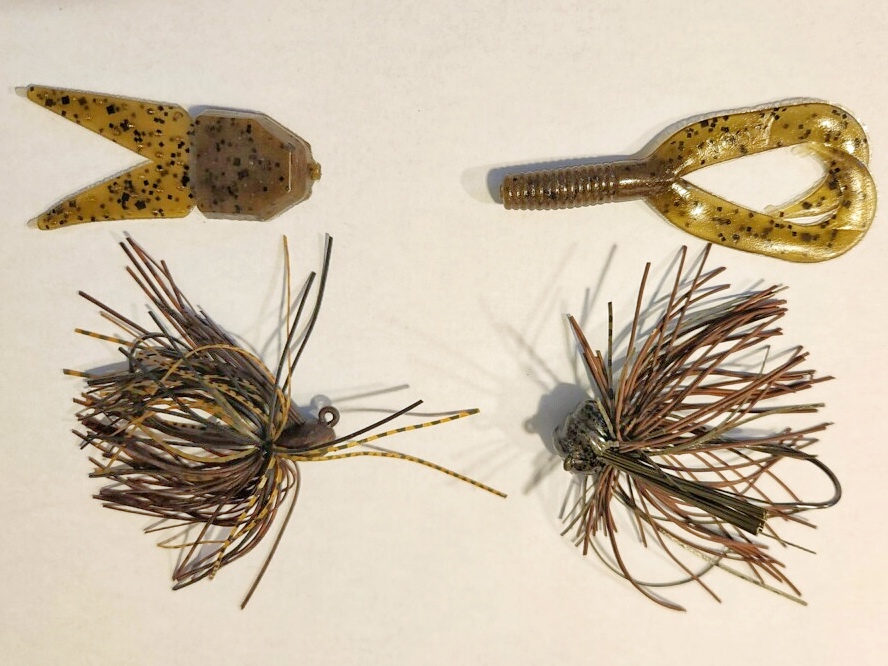
When it comes to fishing a jig in cold water, Bassmaster Elite Series pro Brandon Cobb is one of the best at it. Though he’s an expert at this style of fishing, he admits his approach isn’t all that complicated.
“Either I’m flipping, pitching or casting an arkie jig shallow,” said Cobb. “Or I’m fishing a football jig out deep.”
Altering a few variables, but sticking with these two jigs, Cobb is able to fish a wide range of the water column, around all sorts of cover and for a variety of bass species.

Arkie jig
Cobb’s arkie jig of choice is one he actually designed himself in a collaboration with one of his sponsors, the Greenfish Tackle Brandon Cobb All Purpose Jig.
“I use that All Purpose Jig because it’s decent for dragging, and it also skips decent if you want to fish a dock. You can do almost anything with it.”
Cobb prefers to have one jig on deck he can do a lot with so he can get into a good rhythm. It’s harder to make accurate casts when swapping back and forth from a 3/8-ounce casting jig to 1/2-ounce flipping jig, for instance. Simply sticking with one jig that can do almost anything increases Cobb’s accuracy, as well as his feel for the bait.
“It’s not perfect for flipping wood, but generally in cold water you’re fishing rock just as much as you are wood. And I like to not have to change rods or jigs. So, the arkie is acceptable for any cover.”

Football jig
“And then out deep I go with a football jig, because generally when it’s cold you’re fishing rock, and it comes through rock better.”
Many anglers reach for a ball-head finesse jig when the water temps bottom out. But the football head shape is still the preferred jig for Cobb when it comes to deeper water. Though his football jig has some finesse jig elements to it.
“My football jig is kind of more of a finesse jig. I like spider cut football jigs because we have a lot of spotted bass and they’re easier to hook on that type of jig. So, it’s kind of like a finesse jig with the trimmed skirt, but it’s still a football head.”
Jig size
Cobb opts for a 1/2-ounce in both the arkie jig as well as the football head jig, with a few key acceptations. Fishing bluff walls with an arkie jig is a good example.
“If I have a couple eat it on the fall, then a lot of times I’ll go lighter, if I think they’re not necessarily on the bottom.”
Going with a lighter jig, like a 3/8-ounce, Cobb can slow down the rate of fall of his bait and give the lethargic bass more time to react.
Using a football jig less than 1/2-ounce is almost always out of the question for Cobb, though he may go a little heavier at times.
“I always try to use a 1/2-ounce football jig, unless I’m having trouble keeping it on the bottom. The reason being, fish are easier to hook on a 1/2 than a 3/4. A 3/4 is a big, big head, and when you set the hook, deep especially, you’ll knock their mouths open and have a hard time hooking them.”
Like many of us, Cobb is prone to get in a hurry. He pointed out that he can actually drag a 3/4-ounce football jig too fast at times, while still keeping it on the bottom. Using the lighter 1/2-ounce jig forces him to slow down.

Trailer selection
“In cold water, I like less movement in my jig trailer generally. Something like a Zoom Small Salty Chunk. I don’t like big trailers in the winter, unless I want it to fall ultra slow.”
Though the resistance of larger flapping craws will slow the fall of a jig, Cobb doesn’t like the added action and will simply move from a heavier jig to a lighter one to slow the fall of his bait.
“A Small Salty is my go-to for almost all my jig fishing. And the exception is deep water football jig fishing. I use a very small twin tail, like the Zoom Creepy Crawler, that has a little action but not much. I don’t use the chunk deep because the jig falls too slow.”
Line selection
Line selection when fishing a jig during the winter months is particularly important according to Cobb. He chooses to fish his arkie jig shallow on heavier Yo-Zuri T-7 Premium Fluorocarbon, in the 16- to 20-pound range depending on the cover.
“I have thrown a football jig on as light as 10- to 12-pound, to keep that 1/2-ounce on the bottom. I’ve broken off a jig before and had to pickup another rod with lighter line. It’s actually incredible how much easier it is to keep it on the bottom with 12- versus even 16-pound test.”
As a jig falls, a bow forms in the line. If you’ve ever flown a kite, think about the bow that’s caused in the string by the wind. The same happens under water to your line. The thinner the line, the less the resistance and thus the less extreme the bow.
The lighter pound test gives Cobb a more direct line of contact with his bait. This increases the sensitivity of his presentation and increases his ability to control the jig.
“And you can actually see it with Active Target (forward-facing sonar) now. The jig will just stay on the bottom better. I notice it more with a swimbait and blade runner too. The smallest little movement lifts the bait up 2 feet off the bottom with heavier line. Versus with thinner line you can actually drag your bait on the bottom.”
Cobb uses his ARK Fishing 7-foot, 3-inch Medium Heavy/Fast Do-All Rod for both his arkie jig shallow as well as his football jig deep. Finding the right combination of line, jig and trailer helps Cobb develop a simple winter arsenal that he can do a whole lot with. Take these tips and apply them to your jig fishing this winter and you’ll be sure to catch more fish.
